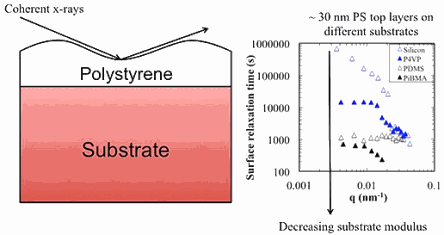Technologies such as microelectronics and lithography require nanoscale polymer films that sit atop various other materials. An understanding of the interplay between the dynamics of the thin film and the underlying substrate is crucial in determining the appropriate materials to be utilized for new and improved applications. Recent experiments at the U.S. Department of Energy Office of Science’s Advanced Photon Source (APS) at Argonne National Laboratory provide new insights on the dynamics of thin polymer films sitting on various substrates and the importance of film thickness and supporting material properties on the surface dynamics of thin polymer films.
Devices that make use of such layers require this crucial knowledge so that appropriate materials can be judiciously chosen. Selecting a polymer based on bulk properties alone is not adequate when working with layers whose thickness is measured in nanometers.
For instance, if a particular polymer is chosen as a microelectronics coating but becomes substantially stiffer or softer when fabricated into nanoscale layers, it may no longer perform as anticipated.
When polymer films are confined to the nanoscale, properties such as the glass transition temperature (Tg), melting temperature, or a measure of stiffness such as the elastic modulus can exhibit large shifts from the way these properties normally behave in larger sizes. These shifts are understood to arise from interfaces, where the dynamics are faster at the polymer-air interface (called the free surface) and slower at the polymer-substrate interface where interactions caused by attraction as opposed to adhesion, such as hydrogen bonding, are present.
The most commonly studied nanoconfined film is polystyrene (PS), which shows a decreasing glass transition temperature as the film thickness decreases because the free surface is highly mobile and the polymer does not exhibit substantial attractive interactions with the supporting substrate. Although Tg changes to nanometer-thick polystyrene are well documented, other properties, such as the dynamics, must be considered when fabricating materials at the nanoscale.
To study such confined films in a greater detail, the researchers in this study from Northwestern University and Argonne used X-ray Science Division beamline 8-ID-I at the APS to measure thermally induced capillary waves at the surfaces of polystyrene films.
The researchers employed x-ray photon correlation spectroscopy (XPCS), which is ideal for probing surface dynamics because x-rays from the APS can be tuned to only penetrate into the top ~10 nm of a film.
With XPCS, the researchers measured constantly fluctuating capillary waves on the surface of a polystyrene film that had been heated to a temperature above the Tg of the polymer.
The researchers were able to discover the role played by polystyrene-film thickness and substrate modulus on the dynamics of surface capillary wave relaxation times.
From measurements taken 10° above the polystyrene glass transition temperature, surface capillary wave relaxation times were found to span orders of magnitude when the PS was placed on substrates with modulus values ranging from ~1 MPa to >100 GPa.
Faster surface dynamics were observed on softer substrates even for films thicker than 100 nm. This thickness is large enough that PS does not show any Tg confinement effects, but shows substrate modulus effects. This result illustrates that Tg and stiffness can be impacted in a very different manner when the polymer film is confined to the nanoscale.
A second finding of this study was that thinner PS films have slower surface wave relaxations than thicker films for a given substrate. Interestingly, the effects of substrate modulus and film thickness disappear when measurements were taken 40° degrees above the Tg of PS, showing that measurement temperature plays a critical role in confinement studies.
Future work by these researchers will look at the dynamics of thin films that have fillers such as nanoparticles or plasticizers added to modify their properties.
See Christopher M. Evans1, Suresh Narayanan2*, Zhang Jiang2, and John M. Torkelson1**, “Modulus, Confinement, and Temperature Effects on Surface CapillaryWave Dynamics in Bilayer Polymer Films Near the Glass Transition,” Phys. Rev. Lett 109, 038302 (2012). DOI:10.1103/PhysRevLett.109.038302
Author affiliations: 1Northwestern University, 2Argonne National Laboratory
Correspondence: **[email protected], *[email protected]
This work was supported by the National Science Foundation-Materials Research Science and Engineering Centers Program (DMR-0520513), Northwestern University (C.M.E.), and 3M (C.M.E.). Use of the Advanced Photon Source at Argonne National Laboratory was supported by the DOE’s Office of Science under Contract No. DE-AC02-06CH11357.
The Advanced Photon Source at Argonne National Laboratory is one of five national synchrotron radiation light sources supported by the U.S. Department of Energy’s Office of Science to carry out applied and basic research to understand, predict, and ultimately control matter and energy at the electronic, atomic, and molecular levels, provide the foundations for new energy technologies, and support DOE missions in energy, environment, and national security. To learn more about the Office of Science x-ray user facilities, visit http://science.energy.gov/user-facilities/basic-energy-sciences/.
Argonne National Laboratory seeks solutions to pressing national problems in science and technology. The nation's first national laboratory, Argonne conducts leading-edge basic and applied scientific research in virtually every scientific discipline. Argonne researchers work closely with researchers from hundreds of companies, universities, and federal, state and municipal agencies to help them solve their specific problems, advance America's scientific leadership and prepare the nation for a better future. With employees from more than 60 nations, Argonne is managed by UChicago Argonne, LLC for the U.S. Department of Energy's Office of Science.

